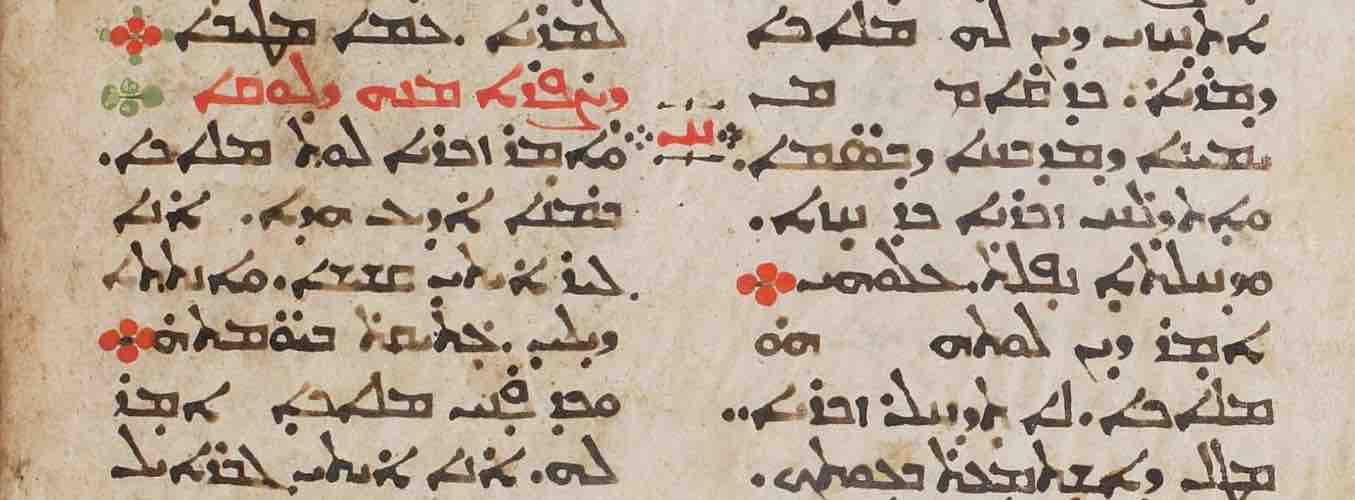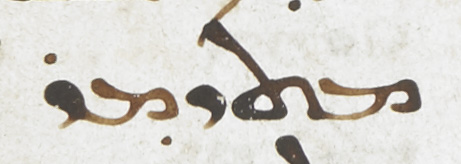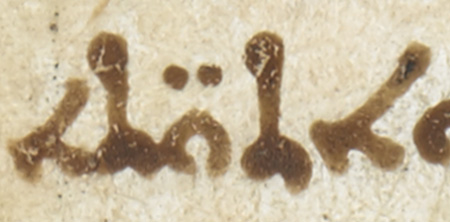Lesson
Syriac Scripts - Earliest Estrangela

Description
Manuscripts survive from as early as the 5th century with the fundamental handwritten form of Syriac script.
Example 1
London, BL Add. 12150, f. 235v (dated 411)
Eusebius of Caesarea
Here we take a look at the earliest Syriac codices, beginning with the earliest dated Syriac manuscript, the famous BL Add. 12150, copied in the year 411, up to about the seventh century. The examples we consider here have similarities with each other as well as with some later Estrangela books, but there are, of course, also more particular characteristics for each scribe’s work. In addition, the assumed hallmarks of a particular letter and script-type may not show up where we expect them to. We see, for example, that the 411 manuscript does not usually have the sharp, angled form of dālat and rēš, but a shape we might describe as perfectly matching a Serto form. The rēš is written in the presumably later (Serto) shape; the dālat is written in both the assumed Estrangela form and in the Serto form. Here we have both dālat and rēš in one word, both in the Serto form.
 © The British Library Board, Add. 12150, f. 235vc, l. 28.
© The British Library Board, Add. 12150, f. 235vc, l. 28.
No attempt will be made to provide a complete inventory of the least common denominators, or fundamental characteristics, for the examples of the handwriting of these manuscripts. But a few observations on letterforms in each manuscript may serve as an initial guide for a foray into these and similar manuscripts. For each chosen manuscript, a sample page in its entirety is included, and a few additional images show specific forms.
Note first of all that the text stands in three columns. Early Syriac manuscripts were mostly written in one or two, less often three, and later there are examples, although few, of four-column manuscripts.
© The British Library Board, Add. 12150, f. 235v.
| ālap | when connected and not, there is a serif on the right leg left leg sits a little below the line top part may have upward turn height of top part varies |
| gāmal | ends well below line, but without the thick dot of some later examples |
| dālat | sometimes with Serto shape, but sometimes distinct from rēš in having usual Estrangela shape |
| hē | center post angles to the left |
| wāw | quite round, but right side usually straighter unclosed loop |
| ḥēt | about the same height as yod |
| ṭēt | very tall |
| yod | final, unconnected form of the angled type, almost like a comma |
| kāp | slightly more sharp than round on top, but not to a point |
| lāmad | very tall notably thicker at the top |
| mim | top horizontal angles notably upward loop open, or barely closed |
| nun | when final and unconnected to previous letter, very thick at the top, very thin thereafter, and sharply angled |
| semkat | very round loops, left one taller does not join following letter |
| ʿē | thick top part relatively narrow angle between top and lower part |
| qop | sharp on the left, more round on the right |
| rēš | typically with Serto shape, and thus often distinct from dālat |
| tāw | very tall loop sometimes open, sometimes closed |
 © The British Library Board, Add. 12150, f. 235va, ll. 20-22.
© The British Library Board, Add. 12150, f. 235va, ll. 20-22.
Example of the ālap with connector-serif
Example 2
Vatican City, Vat Sir. 160, f. 140v (6th C. [?])
Lives of Saints and Martyrs
© Bibliotheca Apostolica Vaticana, Sir. 160, f. 140v.
| ālap | when connected and not, there is a serif on the right leg left leg sits a little below the line top part may have upward turn or serif height of top part varies |
| gāmal | ends well below line, but without the thick dot of some later examples |
| dālat / rēš | usually a very short, round top part yields almost a Serto shape, but sometimes the more usual Estrangela form |
| hē | center post angles to the left |
| wāw | quite round, but right side usually straighter unclosed loop |
| ḥēt | about the same height as yod |
| ṭēt | very tall |
| yod | final, unconnected form with left extender (esp. at line end), or of the angled type final, connected form of the angled type |
| kāp | slightly more sharp than round on top, but not to a point final form with long tail |
| lāmad | very tall, notably thicker at the top |
| mim | loop open |
| semkat | very round loops, left one taller does not join following letter |
| ʿē | elongated initial form relatively narrow angle between top and lower part |
| tāw | very tall, loop open |
 © Bibliotheca Apostolica Vaticana, Sir. 160, f. 140vb, l. 13.
© Bibliotheca Apostolica Vaticana, Sir. 160, f. 140vb, l. 13.
yod — example of the final, unconnected form with left extender, col. b
 © Bibliotheca Apostolica Vaticana, Sir. 160, f. 140va, l. 12.
© Bibliotheca Apostolica Vaticana, Sir. 160, f. 140va, l. 12.
yod — example of the final, unconnected angled form, col. a
 © Bibliotheca Apostolica Vaticana, Sir. 160, f. 140va, l. 1.
© Bibliotheca Apostolica Vaticana, Sir. 160, f. 140va, l. 1.
elongated initial ʿē
Example 3
Diyarbakir, DIYR 339, f. 29v (6th C.)
Gospels (Peshitta)
Diyarbakir, Meryem Ana Syriac Orthodox Church, DIYR 339, f. 29v. All rights reserved. Image provided by HMML.
| ālap | when connected and not, there is a serif on the right leg often sits a little below the line may have an almost upward-turning serif at the top |
| dālat / rēš | rather thick horizontal on top dot of dālat often sits well below |
| hē | the center leg touches neither the left nor the right |
| wāw | not closed when preceding some letters (e.g. šin) may be connected (in Usual Estrangela not attached) |
| ḥēt | notably taller than the yod |
| yod | when final, connected to previous letter or not, a right-pointing angle sitting on the line |
| kāp | much narrower and more rounded than bēt final kāp has a longish top-serif on the left side and ends with a sharp, narrow point on the right |
| lāmad | thick at the top, slender at the bottom |
| mim | the upper horizontal turns upward at the left when non-final, the bottom horizontal is close to the left upright, but the circle is not closed final mim, however, is closed, and has a long, thin, descending point |
| nun | when final and unconnected to previous letter, more angled than when connected |
| semkat | both loops rounded, the left one taller does not join to following letter |
| ʿē | similar in shape to gāmal, but shorter and without hanging below the line |
| pē | the loop is quite open when final, the horizontal ends in a thick dot |
| ṣādē | narrow base at the line, then a thicker, slightly right angling descender, ending with a thin, upturning line |
| rēš | see dālat above |
| šin | an upright base with a shallow bowl on top when initial, often with a long horizontal before the upright base (indistinguishable from the combination yod-šin) |
| tāw | the size of the opening in the loop varies from open to closed the vertical may only angle only slightly to the left |
 Diyarbakir, Meryem Ana Syriac Orthodox Church, DIYR 339, f. 62ra, l. 2. All rights reserved. Image provided by HMML.
Diyarbakir, Meryem Ana Syriac Orthodox Church, DIYR 339, f. 62ra, l. 2. All rights reserved. Image provided by HMML.
f. 62r, with two tightly closed tāws, with only a slightly left-leaning vertical
Example 4
London, BL Add. 14460, f. 80r (dated 599/600)
Gospels (Peshitta)
© The British Library Board, Add. 14460, f. 80r.
| ālap | serif on right leg left leg hangs below line |
| gāmal | ends well below line, but without the thick dot of some later examples |
| dālat / rēš | usually of the presumably typical, angled Estrangela form, but sometimes more round at top |
| hē | center post angled somewhat to the left |
| wāw | very round open loop |
| kāp | quite round |
| mim | open loop, or barely closed final form with very thin tail |
| šin | horizontal line not too thick top line not too round |
| tāw | loop open when unconnected on either side, lacking a proper loop at the bottom the vertical may only angle only slightly to the left |
 © The British Library Board, Add. 14460, f. 80r, l.4.
© The British Library Board, Add. 14460, f. 80r, l.4.
Example of the unconnected, tightly looped, tāw, with only a slightly left-leaning vertical; even with these similar features, the tāw in this example and that of the previously noted DIYR 339 are quite distinct from each other: note the more spacious and sharply angled part to the right of the loop in the DIYR 339 tāw, and note the large dot at the top of the vertical in the example here:
Example 5
Tell Kaif, QACCT 8 (7th C.?)
Gospel Lectionary
Tell Kaif, Qalb Al-Aqdas Chaldean Church, QACCT 8, f. 20r. All rights reserved. Image provided by HMML.
| ālap | does not sit below the line |
| dālat / rēš | in general top line not much thicker than the vertical |
| kāp | sharper descent on the right side |
| yod | when final may have a long extender on the right (at line-end, cf. f. 23va, l. 3) |
Many characteristics in Tell Kaif, QACCT 8 are shared with DIYR 339, but the lines in this manuscript are overall thicker than the other manuscript.
Ready to transcribe?
Try your hand at transcribing Earliest Estrangela scripts